How to safely watch the April 8 total solar eclipse
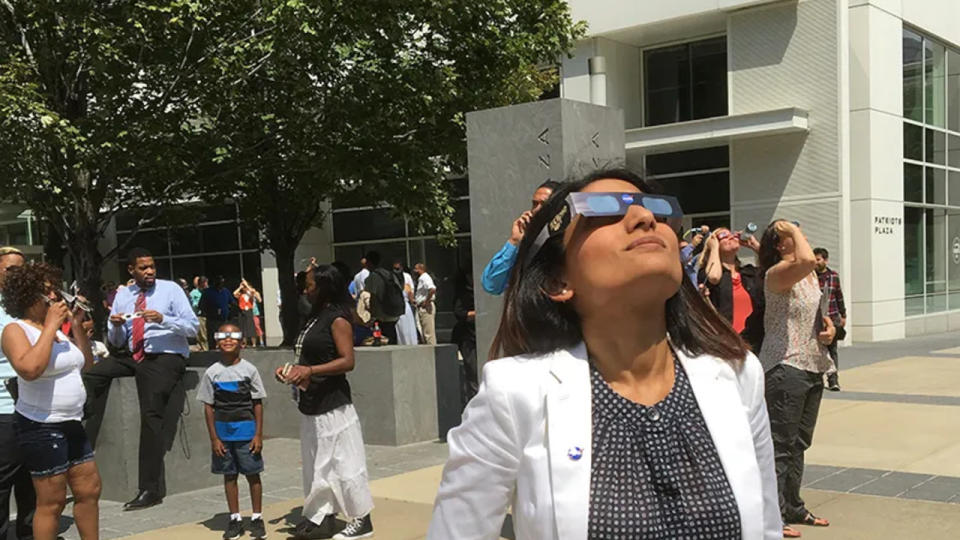
A total solar eclipse is one of the greatest natural wonders to behold. However, viewing one without the proper protection can be dangerous, potentially damaging your eyes permanently. Follow these recommendations to stay safe and protect your eyesight.
On Monday, April 8, 2024, the Moon will pass directly in front of the Sun and cast its shadow across the surface of Earth. Tracing a path from the equatorial Pacific Ocean to the north Atlantic Ocean, the shadow will pass through Mexico, the United States, and then the eastern half of Canada, from southwestern Ontario to Newfoundland.
DON'T MISS: Everything you need to know for April's spectacular and rare solar eclipse
Hundreds of millions of people across North America will have a view of this amazing event, seeing at least a partial solar eclipse on that day. Tens of millions will have a chance to see totality, when the Moon completely blocks the Sun for up to four and a half minutes.
For many, this will be a once-in-a-lifetime astronomical event.
However, while excitement builds as we approach the day, the key to observing the April 8 total solar eclipse is to also observe a few essential safety tips.
RELATED: Preparing for the solar eclipse: Shifty weather brings uncertainty
You can go about your business
The first thing that should be mentioned is that if you're not taking time off from your normal activities to watch the eclipse, April 8 should be like any other Monday.
Unless there's some significant weather event going on, there's no reason to not go outside, or drive your car, or walk your dog. Presumably, you (and your dog) don't spend a lot time staring at the Sun on any other day. So, that should stay the same on the day of the eclipse.
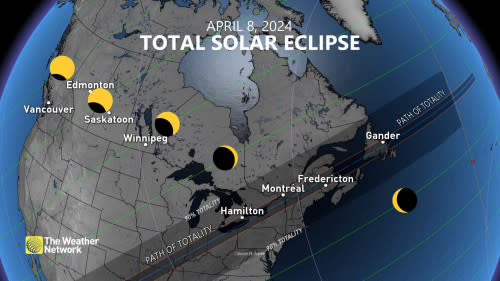
In fact, if you're far enough away from the path of totality (outside of the shaded region of the above map), you will probably not even notice that anything different is occurring. Only when the Moon is covering over 90 per cent of the Sun's disk (within the shaded region on the map) does the sky begin to noticeably dim.
While there are some odd myths about solar eclipses that have surfaced over the years, they are only myths. The only time you really need to take special care is if you do stop to observe the Moon passing in front of the Sun.
SEE ALSO: Strange things may happen during the eclipse, and NASA wants you to document it
Protect your eyes!
A brief glance directly at the Sun can leave temporary spots before our eyes. However, staring at the Sun for any length of time has the potential to cause permanent eye damage. This results from the tissues at the back of our eyes (the retina) becoming scarred by the intense sunlight.
This damage is called solar retinopathy.
Watch below: The dangers of solar retinopathy and how to watch the eclipse safely
It can happen after only a few seconds of exposure, and because there are no pain receptors located in the retina, the person affected may not actually feel anything at all. The only way they'll notice the damage is from the symptoms they experience afterwards, which can include blurred vision, blind spots, changes to their perception of colour, sensitivity to light, and headaches.
If the person is fortunate, the damage could only be temporary, but it may take up to a year for their vision to improve. If they're not so lucky, the damage will be permanent.

Four examples of how a blind spot (central paracentral scotoma) from solar retinopathy could affect your daily life. Credits: Top left, Gorgo/Wikimedia/Public Domain; Top right and bottom left, Mark Robinson/TWN; Bottom right, Laura Chouette/Unsplash
We tend to have a natural aversion to looking directly at the Sun. We typically squint or shut our eyes if we're exposed to too much light. However, as the Sun dims during the eclipse, it will become easier to look at.
Easier, but not safer!
The sky may dim when the eclipse is near or at maximum, but that doesn't mean that the sunlight is any less intense than it usually is at that time of day.
So, even when less than 1 per cent of the Sun is still visible, that is still too much sunlight exposure to safely observe without eye protection! This is especially true due to the inclination to stare directly at that portion of the eclipse for a period of minutes.
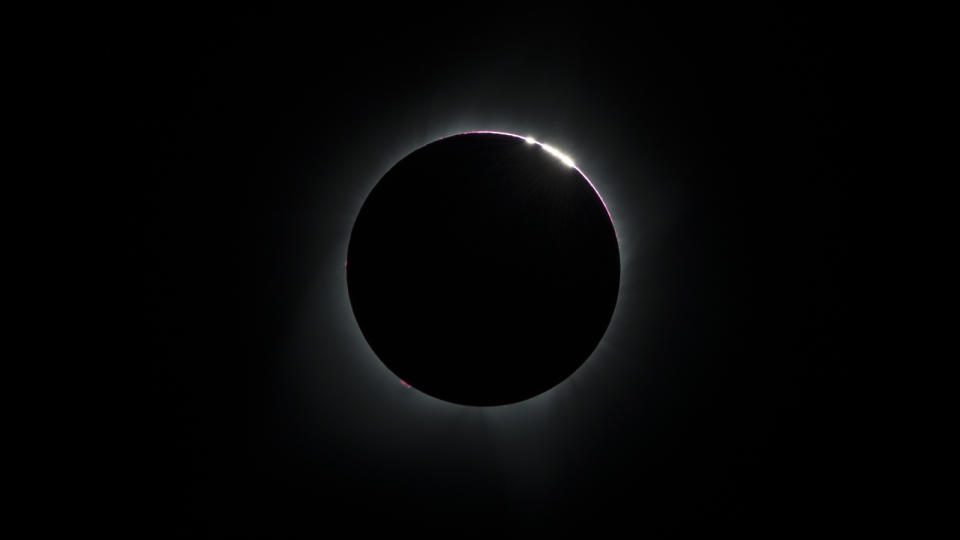
This image from the 2017 total solar eclipse shows a phenomenon known as Baily's Beads, where sunlight shining through valleys along the limb of the Moon form bright points of light. Credit: NASA/Aubrey Gemignani
That is why eye safety is such an important topic when there is an upcoming solar eclipse. And the message carries extra importance for this particular eclipse, as well, due to the number of Canadians who will experience near-totality.
Windsor, Sarnia, London, Kitchener-Waterloo-Cambridge, Guelph, the entire Greater Toronto Area, Barrie, Peterborough and the Kawarthas, Tweed, Kemptville, Ottawa, the northern half of Montreal, Trois-Rivieres, Quebec City, Edmundston, Saint John, Moncton, Charlottetown, Yarmouth, Halifax, Sydney, and St. John's — this is just a sampling of the largest communities that are close enough to the path of totality to notice the sky dim but will not see the Moon completely cover the Sun at maximum eclipse.
How to protect your eyes
There are a few different ways to safely observe a solar eclipse.
The first is to watch it online. The Weather Network will have a live stream of the event on TV, our website, and via our mobile app. This is a perfectly safe method, as the camera recording the eclipse will have a proper filter, and the screen will never get bright enough to cause you any problems.
Second, you can set up an indirect way to watch. This can be as simple as letting sunlight shine through a colander or slotted spoon, or between the leaves of a tree, and seeing the resulting crescents of sunlight appear on the ground. Setting up a mirror to reflect the Sun onto a wall would also work. However, please do not look directly at the reflection of the Sun in the mirror. That would be just as bad as looking directly at the Sun itself. It's the reflection on the wall that you want to observe.

Multiple overlapping solar crescents are visible under this tree during the August 21, 2017 solar eclipse. The image has been cropped from its original dimensions to a 16x9 aspect ratio. Credit: Ron Clausen (CC BY-SA 4.0 DEED)
You can also make a pinhole projector. A common method is to use a cereal box, paper, aluminum foil, scissors, a pin, and tape. NASA has instructions on how to put it all together here.
For a simpler way, grab a push pin and two pieces of white paper or cardstock, and follow along with Planetary Society Junior Ranger CaLisa Lee.
Thirdly, most observers — both within the path of totality and outside of it — will likely be using solar viewing glasses (aka eclipse glasses).
Some high-end versions are plastic and look similar to ordinary sunglasses. However, most are made from printed cardstock and have thin mylar 'lenses'. Even though the 'lenses' on these glasses are so thin, they still block out over 99.99 per cent of all light from the Sun.
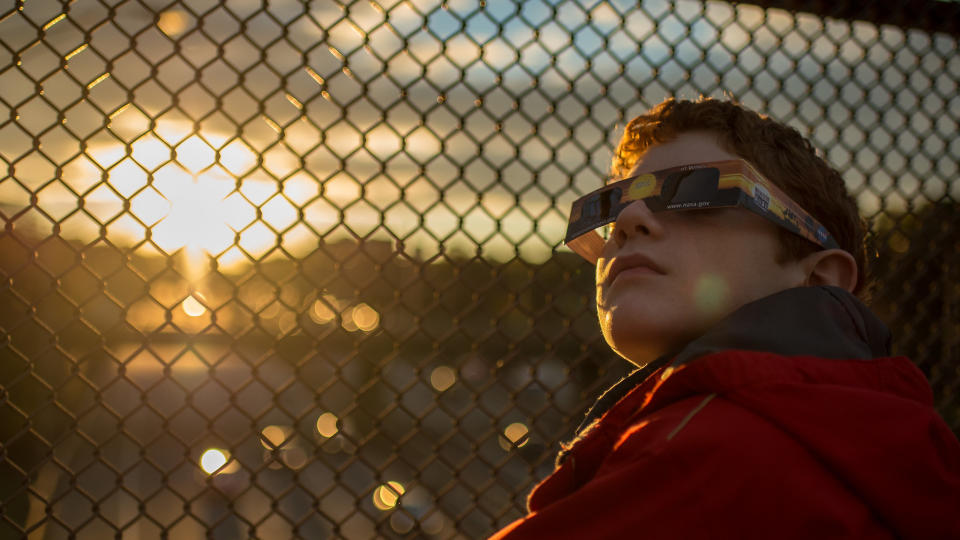
Credit: NASA/Bill Ingalls
One important tip about wearing eclipse glasses: always put them on securely before you look up at the Sun. Similarly, turn away from the Sun before you take them off. This ensures that you're being as safe as possible.
Also, to help kids experience the eclipse safely, NASA has a great way to make wearing eclipse glasses fun, while allowing the kids to express their creativity at the same time.
If you have a pair of these glasses left over from the 2023 or 2017 solar eclipses, great! Just inspect them for damage, first, so there are no cuts, holes, or dents in the lenses that will let in too much light.
Wearing a pair of solar eclipse glasses inside, under normal lighting conditions, you should not be able to see anything through the glasses. A bare incandescent, bright white LED, or bright halogen light bulb can show through very faintly if you're up close, but if you see anything more than that, the glasses should be thrown out.
If you're buying a new pair of solar viewing glasses, to be sure that they are genuine and meet the standards required for safe solar viewing (the ISO 12312-2 international standard), get them from a reputable vendor.
The Royal Astronomical Society of Canada is an excellent source! The American Astronomical Society also has an extensive list of online vendors that sell products that meet those standards.
Alternatively, you can find your local branch of RASC. Many, if not all, RASC centres will be hosting an eclipse viewing party on the day of the event and should have a good supply of eclipse glasses for those attending.
For anyone who wishes to use a camera, telescope, or binoculars during the eclipse, remember to buy a proper solar filter that fits your equipment. Some astronomical companies also make specially-designed solar-viewing binoculars.
What NOT to do
Eclipses generate a lot of attention and excitement, but they also attract a fair amount of misinformation.
First and foremost, to reiterate: Do not look directly at the Sun for any length of time without eye protection — even just for a second is too risky.
For those using a camera, telescope, or binoculars, do not use these devices unfiltered at any time except precisely at the point of totality. The smallest amount of unfiltered sunlight could potentially damage the optics of these devices. Even worse, focused sunlight passing unfiltered through a telescope or binoculars into your eyes could result in permanent injury.
Do not use regular sunglasses to view the eclipse. Even overlapping several pairs will not give you the protection you need.
Do not use any welders glass rated less than "shade 12" to view the eclipse. Most welding masks have glass rated less than that (about shade 10 or 11). So, if you have a welding mask or goggles, be absolutely sure you know their rating and that it's 12 or higher. If you can't verify that, or they're rated less than 12, please don't use it — not even if you try to layer it with something else like sunglasses. It's not worth the potential eye damage.
Do not use any 'homemade' methods people have thought up over the years. This includes:
neutral density or polarizing filters for camera lenses,
smoked glass,
photographic or X-ray film (regardless of whether it is unexposed, exposed, or developed),
space blankets,
potato-chip bags,
DVDs or CDs.
According to the American Astronomical Society: "In some cases these homemade filters may seem like they dim the Sun to a comfortable level, but that doesn't mean they do so across the whole electromagnetic spectrum to which our eyes are sensitive. While you're enjoying a 'comfortable' view of the 'dim' Sun, solar infrared radiation could be cooking your retinas."
WATCH: How to capture the solar eclipse with your phone or DSLR camera
Is there any safe time to look?
There is only one time when looking directly at a solar eclipse without eye protection is safe. This is when you are located directly in the path of totality, and the Moon is completely blocking the Sun at totality.
At that time, you are actually encouraged to take off your eye protection. That way, you can see one of the most spectacular parts of the eclipse — the solar corona.
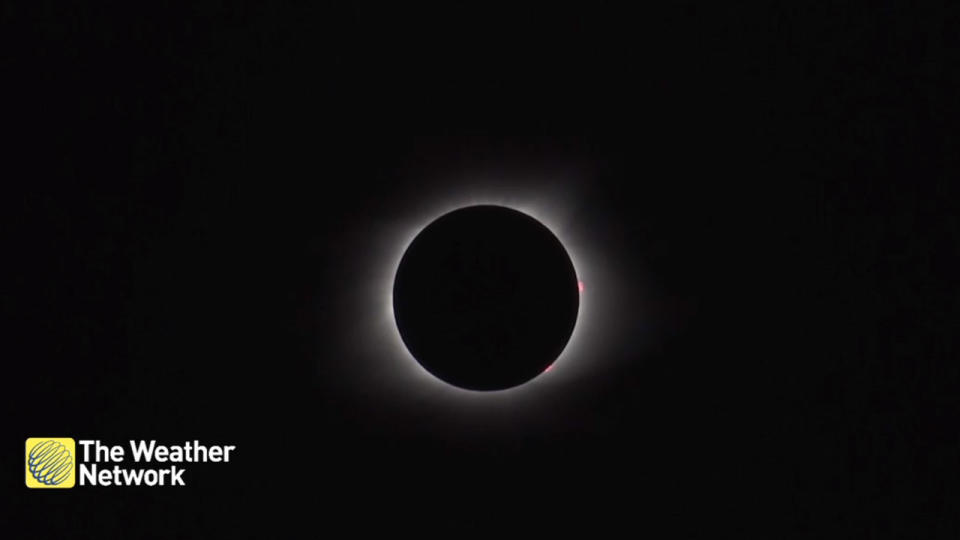
Along the path of totality, observers in Canada will see the Moon completely block the Sun for up to 3 minutes and 46 seconds. The exact duration varies based on location, though. As the point farthest to the southwest and closest to the centre of the path of totality, Fort Erie, on the Niagara Peninsula, will have the longest duration for totality in Canada. The farther you are to the northeast along the path, the shorter totality will be. Also, points closer to the path's edge have shorter totality durations than points closer to the centre.
If you do look directly at the eclipse while experiencing totality, you must be very careful to time it just right!
After observing the eclipse through sun viewers and then standing in the dim light of totality, our pupils will be dilated — opened wide — to take in as much light as possible. It will be like as if we were standing in dark room for all that time. This will make our eyes extremely susceptible to bright light.
Thus, if your eyes are unprotected when the Sun suddenly peaks out around the limb of the Moon, the chances of suffering eye damage could be more significant than at any other moment of the eclipse.
So, be sure to know the exact timing of totality for your area, and put your eclipse glasses back on, or return to your indirect method of viewing, before totality ends!
Editor's note: a previous version of this article stated that you should only be able to see the Sun (or a direct reflection of the Sun in a mirror) through solar eclipse glasses. However, incandescent, LED, and halogen light bulbs can also be seen through the Mylar lenses, although very faintly and from close-up. This information has now been corrected. We apologize for any confusion.
Thumbnail image courtesy NASA/Mamta Patel Nagaraja
Watch below: A rare solar eclipse will be visible from Canada in 2024
A total solar eclipse will plunge parts of North America into temporary daytime darkness on April 8, 2024, as the Moon passes in front of the Sun. Here's everything you need to know about who will see the eclipse and when, and how to view it safely: https://t.co/s5Yl8c6vSW pic.twitter.com/42B0FicQwD
A total solar eclipse will plunge parts of North America into temporary daytime darkness on April 8, 2024, as the Moon passes in front of the Sun. Here's everything you need to know about who will see the eclipse and when, and how to view it safely: The Weather Network on Twitter: "A total solar eclipse will plunge parts of North America into temporary daytime darkness on April 8, 2024, as the Moon passes in front of the Sun. Here's everything you need to know about who will see the eclipse and when, and how to view it safely: https://t.co/s5Yl8c6vSW pic.twitter.com/42B0FicQwD / Twitter" The Weather Network on Twitter: "A total solar eclipse will plunge parts of North America into temporary daytime darkness on April 8, 2024, as the Moon passes in front of the Sun. Here's everything you need to know about who will see the eclipse and when, and how to view it safely: https://t.co/s5Yl8c6vSW pic.twitter.com/42B0FicQwD / Twitter"
— The Weather Network (@weathernetwork) The Weather Network on Twitter: "A total solar eclipse will plunge parts of North America into temporary daytime darkness on April 8, 2024, as the Moon passes in front of the Sun. Here's everything you need to know about who will see the eclipse and when, and how to view it safely: https://t.co/s5Yl8c6vSW pic.twitter.com/42B0FicQwD / Twitter"

 Yahoo Sports
Yahoo Sports 